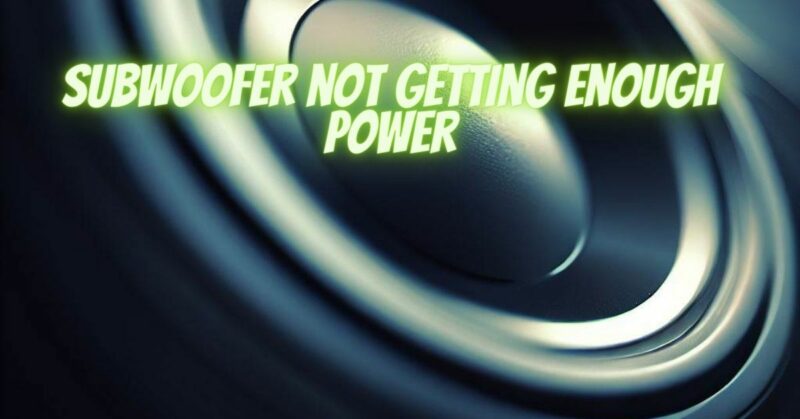A subwoofer that is not receiving enough power can result in a weak bass output and an underwhelming audio experience. Insufficient power can be caused by various factors, including incorrect setup, power supply issues, or a mismatch between the subwoofer and the amplifier. In this article, we will explore common causes of a subwoofer not getting enough power and provide troubleshooting steps to help you resolve the issue and ensure your subwoofer receives the power it needs for optimal performance.
- Check Power Supply:
Start by verifying that the subwoofer is connected to a functioning power outlet. Ensure that the power cable is securely connected to both the subwoofer and the outlet. Try plugging the subwoofer into a different outlet or using a different power cable to rule out any issues with the power source.
- Examine Power Rating:
Ensure that the power rating of the amplifier or receiver driving the subwoofer is compatible with the power requirements of the subwoofer. Mismatched power levels can result in insufficient power delivery. Refer to the subwoofer’s user manual or specifications to determine the recommended power range and ensure it aligns with the amplifier’s capabilities.
- Assess Amplifier Settings:
Review the settings on your amplifier or receiver that control the subwoofer output. Check for any settings related to subwoofer level, crossover frequency, or bass management. Adjust these settings as necessary to ensure the subwoofer is receiving the appropriate signal and power from the amplifier.
- Verify Subwoofer Connections:
Ensure that the subwoofer is properly connected to the amplifier or receiver. Check the cables running from the amplifier’s subwoofer output to the subwoofer’s input. Ensure the connections are secure and free from any damage or corrosion that could impede power delivery.
- Check Subwoofer Level and Gain:
Review the level and gain settings on the subwoofer itself. These controls can vary depending on the model and manufacturer. Adjust the subwoofer’s level or gain knob to ensure it is appropriately set to match the overall audio balance and to optimize the subwoofer’s power output.
- Consider Power Requirements:
Subwoofers often have specific power requirements, including voltage and amperage ratings. Verify that the power supply meets these specifications. If necessary, consult the subwoofer’s user manual or contact the manufacturer to ensure you are using the correct power supply for your specific model.
- Seek Professional Assistance:
If you have tried the above steps and are still experiencing insufficient power to the subwoofer, it may be necessary to seek professional assistance. A qualified audio technician can diagnose any underlying issues with the amplifier, power supply, or subwoofer itself and provide appropriate solutions.
Conclusion:
A subwoofer not receiving enough power can result in weak bass output and diminished audio quality. By following the troubleshooting steps outlined in this article, you can identify and address the causes of insufficient power to your subwoofer. Ensure proper power supply, check amplifier settings, verify connections, and consider the subwoofer’s power requirements. If needed, seek professional assistance to diagnose and resolve any underlying technical issues. With sufficient power, your subwoofer will deliver the deep, impactful bass that enhances your audio experience.


